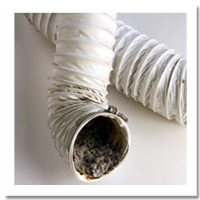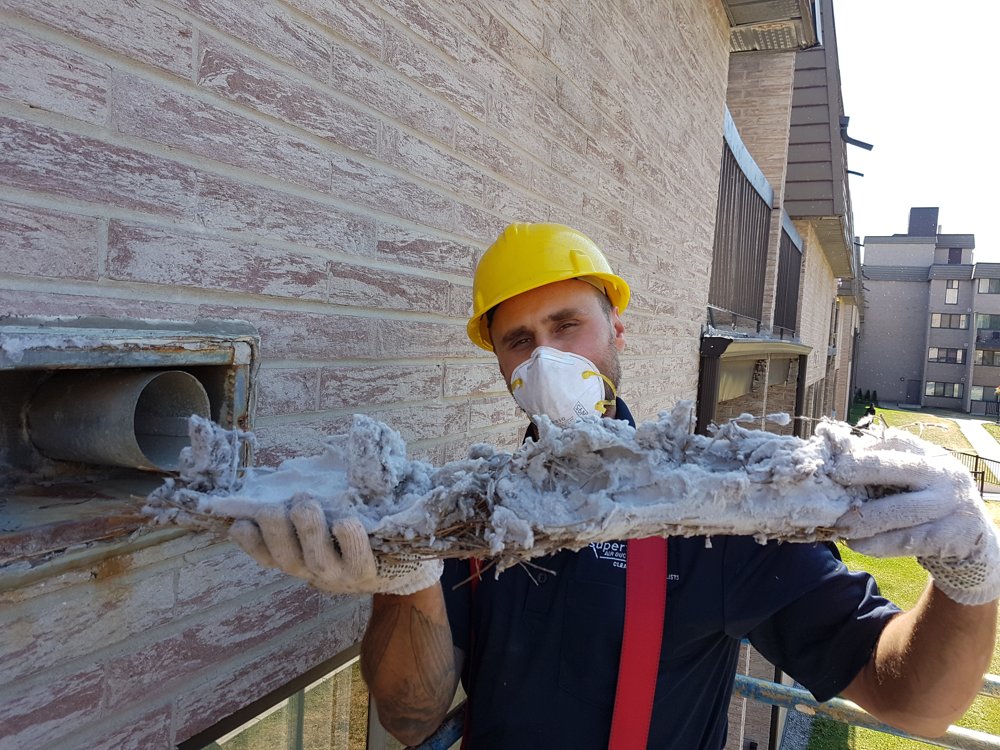
With the buildup of lint in your dryer lines, your dryer’s efficiency is reduced, requiring longer drying periods.
This could also mean that you’re spending more of your hard-earned money on drying laundry. Even more importantly, this blockage could become a fire hazard, as lint is a highly flammable substance.
If you’re noticing that it is taking longer for your clothes to dry, then it may be time to have your dryer lines cleaned. Regular maintenance will also increase the lifespan of your dryer by preventing your fan motor from being overworked. Superior Air Duct Cleaning also offers replacement options for older plastic lines, upgrading them to new, professionally installed aluminum flex ducts.
These newer options offer extra peace of mind for customers, as if a spark ever occurs, it will be contained within the line and not spread into your home.
Process

- Dryer hose is disconnected from the dryer.
- The dryer is precisely cleaned using air-powered instruments.
- Flexible air rods are inserted along the entire dryer line with special fittings that loosen the lint from the walls of the line.
- A large vacuum draws out all of the debris.
- All components are then reassembled and the dryer is turned on and inspected to ensure proper cleaning. If required, an aluminum flex line would then be installed in place of the pre-existing plastic line.
At Superior, we offer specialty services for condos and town homes using lift equipment to access exhausts from the exterior. This allows for efficient service without access into resident units.
Below is an article from the Office of the Ontario Fire Marshal
FIRE HAZARDS ASSOCIATED WITH HOUSEHOLD CLOTHES DRYERS
(External Distribution)
Last year, 340 household clothes dryer fires were reported in Ontario. Almost one-third of these incidents were due to a lack of maintenance. Provincial statistics indicate that, on average, 300 clothes dryer fires are reported annually. Although there have been no fatalities within the past 10 years, up to 15 injuries and a few million dollars in property damage results each year.
The design and internal mechanism of most clothes dryers are similar. The majority come in two sizes: full and compact. (Compact dryers are commonly found in apartments stacked above the washing machine to save space.) Heat for clothes dryers is provided by an electrical, natural gas or propane source, with electrical being the most common. At this time, fire hazards do not appear to be associated with any particular brand of clothes dryers.
Normal clothing is dried at an air temperature of about 60°C while permanent press clothing is dried at about 50°C. Clothing made of cotton fabric or man-made plastic material when combined with the accumulated lint in the dryer has an approximate flash ignition and auto-ignition temperature above 200°C. Safety features built into clothes dryers include two or three high-limit switches at the heating elements which stops any thermal runaway condition by cutting off the power at about 120°C. Under normal conditions, there is a considerable margin of safety before the ignition point of clothing is reached. In addition, the dryer drums within the dryer cabinets are designed to act to as a fire barrier to slow the spread of fire.
Major fire hazards associated with clothes dryers include:

- Lack of maintenance
- Improper installation (venting)
- Drying flammable materials
- Accumulation of lint
- Use of plastic ducts
The lack of maintenance/care and improper installation (i.e., incorrect venting) are the leading causes of fires in clothes dryers. Fires also occur when flammable materials are inadvertently put into these appliances. If a fire occurs, it will often start within the drum of the dryer and be fueled by lint that has accumulated in the dryer cabinet. In the event that plastic ducting is used to vent the dryer instead of metal ducting, the fire will not be contained within the dryer if the plastic ducting ignites or melts.
The attached information has been prepared to help minimize the fire hazards associated with clothes dryers. To enhance public awareness, fire departments are encouraged to distribute this information within their communities.
If you have an inquiry, contact your Regional Office of the Fire Marshal.
